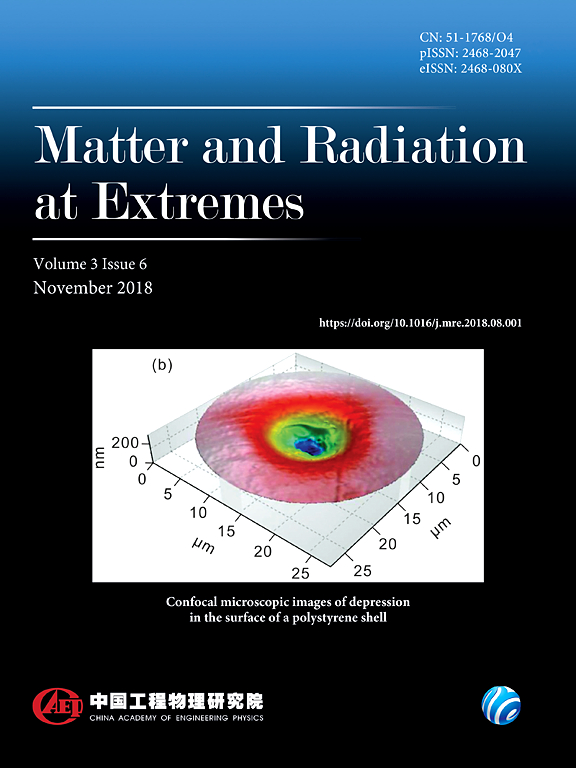Virtual source approach for maximizing resolution in high-penetration gamma-ray imaging
IF 4.7
1区 物理与天体物理
Q1 PHYSICS, MULTIDISCIPLINARY
引用次数: 0
Abstract
High-energy gamma-ray radiography has exceptional penetration ability and has become an indispensable nondestructive testing (NDT) tool in various fields. For high-energy photons, point projection radiography is almost the only feasible imaging method, and its spatial resolution is primarily constrained by the size of the gamma-ray source. In conventional industrial applications, gamma-ray sources are commonly based on electron beams driven by accelerators, utilizing the process of bremsstrahlung radiation. The size of the gamma-ray source is dependent on the dimensional characteristics of the electron beam. Extensive research has been conducted on various advanced accelerator technologies that have the potential to greatly improve spatial resolution in NDT. In our investigation of laser-driven gamma-ray sources, a spatial resolution of about 90 µm is achieved when the areal density of the penetrated object is 120 g/cm2. A virtual source approach is proposed to optimize the size of the gamma-ray source used for imaging, with the aim of maximizing spatial resolution. In this virtual source approach, the gamma ray can be considered as being emitted from a virtual source within the convertor, where the equivalent gamma-ray source size in imaging is much smaller than the actual emission area. On the basis of Monte Carlo simulations, we derive a set of evaluation formulas for virtual source scale and gamma-ray emission angle. Under optimal conditions, the virtual source size can be as small as 15 µm, which can significantly improve the spatial resolution of high-penetration imaging to less than 50 µm.最大限度提高高穿透伽马射线成像分辨率的虚拟源方法
高能伽马射线射线摄影具有超强的穿透能力,已成为各个领域不可或缺的无损检测(NDT)工具。对于高能光子,点投影射线摄影几乎是唯一可行的成像方法,其空间分辨率主要受伽马射线源大小的限制。在传统的工业应用中,伽马射线源通常以加速器驱动的电子束为基础,利用轫致辐射过程。伽马射线源的大小取决于电子束的尺寸特征。人们对各种先进的加速器技术进行了广泛的研究,这些技术有可能大大提高无损检测的空间分辨率。在我们对激光驱动伽马射线源的研究中,当被穿透物体的平均密度为 120 g/cm2 时,空间分辨率可达到约 90 µm。为了最大限度地提高空间分辨率,我们提出了一种虚拟源方法来优化成像所用伽马射线源的大小。在这种虚拟源方法中,伽马射线可被视为从转换器内的一个虚拟源发射的,成像中的等效伽马射线源尺寸比实际发射区域要小得多。在蒙特卡洛模拟的基础上,我们得出了一套虚拟源规模和伽马射线发射角的评估公式。在最佳条件下,虚拟源的尺寸可以小到 15 微米,这可以大大提高高穿透成像的空间分辨率,使其小于 50 微米。
本文章由计算机程序翻译,如有差异,请以英文原文为准。
求助全文
约1分钟内获得全文
求助全文
来源期刊

Matter and Radiation at Extremes
Physics and Astronomy-Atomic and Molecular Physics, and Optics
CiteScore
8.60
自引率
9.80%
发文量
160
审稿时长
15 weeks
期刊介绍:
Matter and Radiation at Extremes (MRE), is committed to the publication of original and impactful research and review papers that address extreme states of matter and radiation, and the associated science and technology that are employed to produce and diagnose these conditions in the laboratory. Drivers, targets and diagnostics are included along with related numerical simulation and computational methods. It aims to provide a peer-reviewed platform for the international physics community and promote worldwide dissemination of the latest and impactful research in related fields.
 求助内容:
求助内容: 应助结果提醒方式:
应助结果提醒方式:


